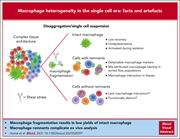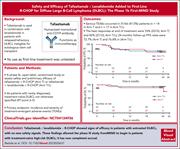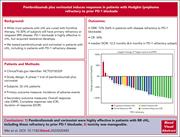Issue Archive
Table of Contents
BLOOD COMMENTARIES
BLOOD SPOTLIGHT
Macrophage heterogeneity in the single-cell era: facts and artifacts
In this Blood Spotlight, Hume et al address what we can learn about macrophage biology through single-cell RNA sequencing (scRNA-seq) analyses. The authors highlight important caveats relating to tissue disaggregation, including the fragmentation of macrophages that can lead to underrepresentation in scRNA-seq datasets and that the attachment of fragments to unrelated cells may lead to misassignment of transcripts. These concerns demand orthogonal confirmation of single-cell findings, wherever possible.
CLINICAL TRIALS AND OBSERVATIONS
Safety and efficacy of tafasitamab with or without lenalidomide added to first-line R-CHOP for DLBCL: the phase 1b First-MIND study
Clinical Trials & Observations
In a phase 1b trial of the addition of the anti-CD19 antibody tafasitamab to R-CHOP (rituximab, cyclophosphamide, doxorubicin, vincristine, and prednisone), Belada et al randomly assigned patients with newly diagnosed diffuse large B-cell lymphoma (DLBCL) with a poor prognosis (International Prognostic Index score of 2-5) to also receive lenalidomide. The authors’ data from 66 patients suggest acceptable safety and encouraging efficacy with 2-year progression-free survival exceeding 74%, thereby forming the basis for a phase 3 trial in high-risk patients with DLBCL.
LYMPHOID NEOPLASIA
Pembrolizumab plus vorinostat induces responses in patients with Hodgkin lymphoma refractory to prior PD-1 blockade
Clinical Trials & Observations
Classical Hodgkin lymphoma (cHL) is highly sensitive to treatment with inhibitors of programmed cell death protein 1 (PD-1), but a significant proportion of patients have resistant disease. Mei and colleagues report on the results of combining the histone deacetylase inhibitor vorinostat, which can increase major histocompatibility complex class 1 expression, with the PD-1 inhibitor pembrolizumab, demonstrating an impressive response rate of 78% in 32 patients with relapsed cHL. Responses in 56% of patients with disease refractory prior to PD-1 therapy suggest this combination warrants further exploration in this difficult-to-treat population.
THROMBOSIS AND HEMOSTASIS
Atypical hemolytic uremic syndrome in the era of terminal complement inhibition: an observational cohort study
CME
Clinical Trials & Observations
In this month’s CME article, Brocklebank et al present detailed clinical characteristics and complete genetic analyses of a large United Kingdom cohort of patients with suspected complement-associated atypical hemolytic uremic syndrome (CaHUS) treated with eculizumab. The authors demonstrate superiority over historical therapies in genotype-matched patients with CaHUS, document that outcome after eculizumab cessation is genotype-dependent, and show that relapse is very unlikely if no pathogenic gene variant is present. The data also reveal a new causative genetic lesion for eculizumab-refractory CaHUS and provide a benchmark that should prove useful as additional options for CaHUS treatment emerge.
TRANSPLANTATION
Gut microbiota diversity before allogeneic hematopoietic stem cell transplantation as a predictor of mortality in children
Masetti and colleagues report on a multicenter observational study of 90 children that investigated the role of the microbiome in pediatric allogeneic hematopoietic stem cell transplantation (allo-HSCT). The authors’ results indicate that patients with high fecal microbial diversity prior to allo-HSCT have longer overall survival and lower incidence of acute graft-versus-host disease compared with patients with low microbial diversity. Higher pretransplant diversity is associated with higher abundance of short-chain fatty acid–producing organisms, suggesting a potentially causative relationship, as has also been observed in adult allo-HSCT recipients.
LETTER TO BLOOD
Genetic drivers in the natural history of chronic lymphocytic leukemia development as early as 16 years before diagnosis
BLOOD WORK
ERRATUM
CONTINUING MEDICAL EDUCATION (CME) QUESTIONS
-
Cover Image
Cover Image
![issue cover]()
Multiplex immunofluorescence of a lymph node from a PD-1 refractory patient with Hodgkin lymphoma. PD-1+ CD8+ T cells (dark green) and PD-1+ CD4+ T cells (dark purple) surround Hodgkin and Reed-Sternberg cells (white) more than their PD-1 counterparts (light purple and light green). See the article by Mei et al on page 1359.
- PDF Icon Front MatterFront Matter
- PDF Icon Table of ContentsTable of Contents
- PDF Icon Editorial BoardEditorial Board
Advertisement intended for health care professionals
Email alerts
Advertisement intended for health care professionals









A new frontier for R-CHOP: is two better than one?
Clinical Trials & Observations